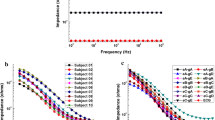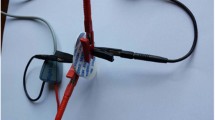Abstract
Electrical impedance tomography (EIT) is an emerging medical imaging technique, which has already been investigated in several clinical applications due to its low-cost, non-invasiveness, non-radioactivity, high temporal resolution, and great sensitivity to impedance changes. One potential use of EIT is to perform long-term continuous imaging monitoring of brain for patients who suffer from severe cerebral diseases. However, this application requires a demanding performance of electrodes because of the characteristics of cerebral EIT measurements. Although Ag/AgCl bio-electrodes are widely used for clinical practices or EIT research at the moment, influences of different types of Ag/AgCl electrodes on cerebral EIT measurements have not been investigated. In this study, five common types of Ag/AgCl bio-electrodes were put into comparison by measuring the forearm and the brain of 10 healthy adult volunteers and evaluating those data in frequency or time domain in terms of contact impedance, uniformity, signal-to-noise ratio, and stability. Results show that Ag/AgCl powder electrode has an overall best performance with as low contact impedance as commercial ECG electrodes (p > 0.05), high SNR (60.3 ± 4.5 dB), better uniformity (coefficient of correlation 0.95 ± 0.03), and greater stability (slope 0.68 ± 0.03). After further improvement in design and instrumentation, Ag/AgCl powder electrode is likely to become the optimal choice for cerebral EIT measurements and provide feasible technical support for further research or application in cerebral EIT.






Similar content being viewed by others
References
Barber, D. C. Electrical impedance tomography. In: The Biomedical Engineering Handbook (2nd ed.), edited by D. C. Barber. Boca Raton: CRC Press, 2000, pp. 1151–1164.
Bayford, R. Bio-impedance tomography (electrical impedance tomography). Annu. Rev. Biomed. Eng. 8:63–91, 2006.
Binnie, C., A. Rowan, and T. Gutter. A Manual of Electroencephalographic Technology. Cambridge: Cambridge University Press, 1982.
Boone, K., and D. S. Holder. Assessment of noise and drift artefacts in electrical impedance tomography measurements using the Sheffield Mark-I system. Innov. Technol. Biol. Med. 16:49–60, 1995.
Boone, K. G., and D. S. Holder. Effect of skin impedance on image quality and variability in electrical impedance tomography: a model study. Med. Biol. Eng. Comput. 34:351–354, 1996.
Brown, B., D. Barber, and A. Seagar. Applied potential tomography: possible clinical application. Clin. Phys. Physiol. Meas. 6:109–121, 1989.
Cherepenin, V., A. Karpov, A. Korjenevsky, V. Kornienko, Y. Kultiasov, A. Mazaletskaya, and D. Mazourov. Preliminary static EIT images of the thorax in health and disease. Physiol. Meas. 23:33–41, 2002.
Dai, M., L. Wang, C. Xu, L. Li, G. Gao, and X. Dong. Real-time imaging of subarachnoid hemorrhage in piglets with electrical impedance tomography. Physiol. Meas. 31:1229–1239, 2010.
Duan, Y., G. M. Clark, and R. Cowan. Factors determining and limiting the impedance behavior of implanted bio-electrodes. In: Proceedings of SPIE-The International Society for Optical Engineering, 2001, pp. 498–508.
Duan, Y., G. M. Clark, and R. Cowan. A study of intra-cochlear electrodes and tissue interface by electrochemical impedance methods in vivo. Biomaterials 25:3813–3828, 2004.
Fabrizi, L., A. McEwan, D. Oh, and D. S. Holder. Analysis of resting noise characteristics of three EIT systems in order to optimize time difference imaging with scalp electrodes during epileptic seizures. Proc. IFMBE 17:568–571, 2007.
Fabrizi, L., R. Yerworth, A. McEwan, O. Gilad, R. Bayford, and D. S. Holder. A method for removing artefacts from continuous EEG recordings during functional electrical impedance tomography for the detection of epileptic seizures. Physiol. Meas. 31:57–72, 2010.
Gagnon, H., M. Cousineau, A. Adler, and A. Hartinger. A resistive mesh phantom for assessing the performance of EIT systems. IEEE Trans. Biomed. Eng. 57:2257–2266, 2010.
Hahn, G., J. Dittmar, A. Just, M. Quintel, and G. Hellige. Different approaches for quantifying ventilation distribution and lung tissue properties by functional EIT. Physiol. Meas. 31:S73–S84, 2010.
Holder, D. S., A. Rao, and Y. Hanquan. Imaging of physiologically evoked responses by electrical impedance tomography with cortical electrodes in the anaesthetized rabbit. Physiol. Meas. 4A:A179–A186, 1996.
Horesh, L., S. R. Arridge, and D. S. Holder. Some novel approaches large scale algorithms for multi-frequency electrical impedance tomography of the human head. PhD Thesis University College London. 2006.
Kuen, J., E. J. Woo, and J. K. Seo. Multi-frequency time difference complex conductivity imaging of canine and human lungs using the KHU Mark1 EIT system. Physiol. Meas. 30:149–164, 2009.
Marquez, J. C., F. Seoane, E. Välimäki, and K. Lindecrantz. Textile electrodes in electrical bioimpedance measurements: a comparison with conventional Ag/AgCl electrodes. Conf. Proc. IEEE Eng. Med. Biol. Soc. 48:16–19, 2009.
Mayotte, M., J. Webster, and W. Tompkins. A comparison of electrodes for potential use in paediatric/infant apnoea monitoring. Physiol. Meas. 15:459–467, 1994.
McAdams, E. T., J. Jossinet, A. Lackermeier, and F. Risacher. Factors affecting electrode–gel–skin interface impedance in electrical impedance tomography. Med. Biol. Eng. Comput. 34:397–408, 1996.
McEwan, A., G. Cusick, and D. S. Holder. A review of errors in multi-frequency EIT instrumentation. Physiol. Meas. 28:197–215, 2007.
Medrano, G., A. Ub, N. Zimmermann, T. Gries, and S. Leonhardt. Skin electrode impedance of textile electrodes for bio-impedance spectroscopy. Proc. IFMBE 17:260–263, 2007.
Mohamad, R., M. K. Joo, D. Andreas, T. Andrew, and B. Richard. A comparison study of electrodes for neonate electrical impedance tomography. Physiol. Meas. 30:73–84, 2009.
Prasad, S. N., D. Houserkova, and J. Campbell. Breast imaging using 3D electrical impedence tomography. Biomed. Pap. Med. Fac. Univ. Palacky. Olomouc. Czech. Repub. 152:151–154, 2008.
Puurtinen, M. M., S. M. Komulainen, P. K. Kauppien, J. A. Malmivuo, and J. A. Hyttinen. Measurements of noise and impedance of dry and wet textile electrodes and textile electrodes with hydrogel. Conf. Proc. IEEE Eng. Med. Biol. Soc. 1:6012–6015, 2006.
Romsauerova, A., A. McEwan, L. Fabrizi, and D. S. Holder. Evaluation of the performance of the multifrequency electrical impedance tomography (MFEIT) intended for imaging acute stroke. Proc. IFMBE 17:543–547, 2007.
Romsauerova, A., A. McEwan, and D. S. Holder. Identification of a suitable current waveform for acute stroke imaging. Physiol. Meas. 27:211–219, 2006.
Rosell, J., J. Colominas, P. Riu, R. Pallas-Areny, and J. G. Wester. Skin Impedance from 1 Hz to 1 MHz. IEEE Trans. Biomed. Eng. 35:649–651, 1988.
Searle, A., and L. Kirkup. A direct comparison of wet, dry and insulating bioelectric recording electrodes. Physiol. Meas. 21:271–283, 2000.
Shi, X., and X. Dong. Pseudo-polar drive patterns for brain electrical impedance tomography. Physiol. Meas. 27:1071–1080, 2006.
Shi, X., X. Dong, F. You, F. Fu, and R. Liu. High precision multi-frequency electrical impedance tomography system and preliminary imaging results on saline tank. In: IEEE-EMBS 27th Annual International Conference the IEEE, 2005, pp. 1492–1495.
Shi, X., X. Dong, F. You, F. Fu, R. Liu, and M. Dai. Preliminary research on monitoring of cerebral ischemia using electrical impedance tomography technique. Conf. Proc. IEEE Eng. Med. Biol. Soc. 2008:1188–1191, 2008.
Shuai, W., F. You, H. Zhang, W. Zhang, F. Fu, X. Shi, R. Liu, T. Bao, and X. Dong. Application of electrical impedance tomography for continuous monitoring of retroperitoneal bleeding after blunt trauma. Ann. Biomed. Eng. 37:2373–2379, 2009.
Shuai, W., F. You, H. Zhang, W. Zhang, F. Fu, X. Shi, R. Liu, C. Xu, X. Dong, and T. Bao. Image monitoring of an intraperitoneal bleeding model of pigs using electrical impedance tomography. Physiol. Meas. 29:217–225, 2008.
Taktak, A., P. Record, R. Gadd, and P. Rolfe. Practical factors in neonatal lung imaging using electrical impedance tomography. Med. Biol. Eng. Comput. 33:202–205, 1995.
Tidswell, A., P. Bagshaw, and D. S. Holder. A comparison of headnet electrode arrays for electrical impedance tomography of the human head. Physiol. Meas. 24:527–544, 2003.
Tidswell, A., A. Gibson, R. H. Bayford, and D. S. Holder. Validation of a 3D reconstruction algorithm for EIT of human brain function in a realistic head-shaped tank. Physiol. Meas. 22:177–185, 2001.
Tidswell, A., A. Gibson, R. H. Bayford, and D. S. Holder. Three-dimensional electrical impedance tomography of human brain activity. Neuroimage 13:283–294, 2001.
Wang, P., M. Tang, M. McCormick, and X. Dong. Preliminary results from an EIT breast imaging simulation system. Physiol. Meas. 22:39–48, 2001.
Woo, E., P. Hua, J. Webster, W. Tompkins, and R. PallasAreny. Skin impedance measurements using simple and compound electrodes. Med. Biol. Eng. Comput. 30:97–102, 1992.
Xu, C., X. Dong, F. Fu, W. Shuai, X. Liu, and C. Zhang. A novel image monitoring software system of electrical impedance tomography for internal hemorrhage. In: World Congress on Medical Physics and Biomedical Engineering, 2006, pp. 3882–3885.
Xu, C., L. Wang, X. Shi, F. You, F. Fu, R. Liu, M. Dai, Z. Zhao, G. Gao, and X. Dong. Real-time imaging and detection of intracranial haemorrhage by electrical impedance tomography in a piglet model. J. Int. Med. Res. 38:1596–1604, 2010.
Yin, Y., Z. Ji, W. Zhang, N. Wang, F. Fu, R. Liu, F. You, X. Shi, and X. Dong. Comparison of three kinds of electrode–skin interface for electrical impedance scanning. Ann. Biomed. Eng. 38:2032–2039, 2010.
Zhang, J., and R. P. Patterson. Analysis on the influence of tissues/organs’ movements in EIT images of lung ventilation using finite difference thorax models. Conf. Proc. IEEE Eng. Med. Biol. Soc. 2:1557–1560, 2004.
Acknowledgments
The authors would like to gratefully acknowledge Prof. Yanwen Duan with College of Chemistry and Molecular Sciences, Wuhan University, Wuhan, China, for providing several types of electrode system for cerebral EIT. This study was partially supported by the PNSF of China under Grants 50937005 and 61071033, and the KPNSTPP of China under Grants 2009BAI79B03.
Author information
Authors and Affiliations
Corresponding authors
Additional information
Associate Editor James Tunnell oversaw the review of this article.
Shiwei Xu and Meng Dai contributed equally to this work.
Rights and permissions
About this article
Cite this article
Xu, S., Dai, M., Xu, C. et al. Performance Evaluation of Five Types of Ag/AgCl Bio-Electrodes for Cerebral Electrical Impedance Tomography. Ann Biomed Eng 39, 2059–2067 (2011). https://doi.org/10.1007/s10439-011-0302-9
Received:
Accepted:
Published:
Issue Date:
DOI: https://doi.org/10.1007/s10439-011-0302-9




